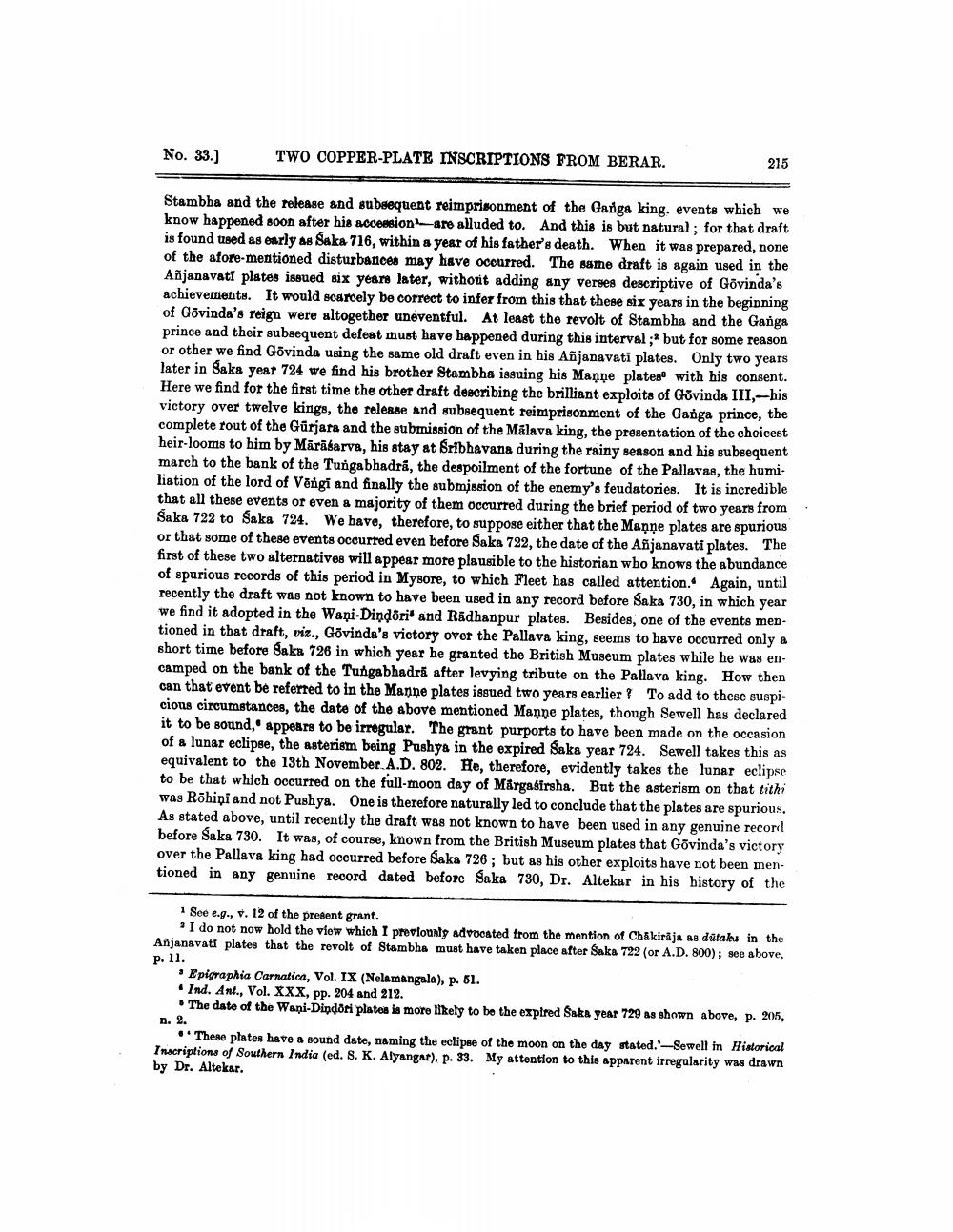________________
TWO COPPER-PLATE INSCRIPTIONS FROM BERAR.
Stambha and the release and subsequent reimprisonment of the Ganga king. events which we know happened soon after his accessionare alluded to. And this is but natural; for that draft is found used as early as Saka 716, within a year of his father's death. When it was prepared, none of the afore-mentioned disturbances may have occurred. The same draft is again used in the Añjanavati plates issued six years later, without adding any verses descriptive of Govinda's achievements. It would scarcely be correct to infer from this that these six years in the beginning of Govinda's reign were altogether uneventful. At least the revolt of Stambha and the Ganga prince and their subsequent defeat must have happened during this interval; but for some reason or other we find Govinda using the same old draft even in his Añjanavati plates. Only two years later in Saka year 724 we find his brother Stambha issuing his Manne plates with his consent. Here we find for the first time the other draft describing the brilliant exploits of Govinda III,-his victory over twelve kings, the release and subsequent reimprisonment of the Ganga prince, the complete rout of the Gurjara and the submission of the Malava king, the presentation of the choicest heir-looms to him by Marasarva, his stay at Sribhavana during the rainy season and his subsequent march to the bank of the Tungabhadra, the despoilment of the fortune of the Pallavas, the humiliation of the lord of Vengi and finally the submission of the enemy's feudatories. It is incredible that all these events or even a majority of them occurred during the brief period of two years from Šaka 722 to Saka 724. We have, therefore, to suppose either that the Manne plates are spurious or that some of these events occurred even before Saka 722, the date of the Añjanavati plates. The first of these two alternatives will appear more plausible to the historian who knows the abundance of spurious records of this period in Mysore, to which Fleet has called attention. Again, until recently the draft was not known to have been used in any record before Saka 730, in which year we find it adopted in the Wani-Dindori and Radhanpur plates. Besides, one of the events mentioned in that draft, viz., Govinda's victory over the Pallava king, seems to have occurred only a short time before Saka 726 in which year he granted the British Museum plates while he was encamped on the bank of the Tungabhadra after levying tribute on the Pallava king. How then can that event be referred to in the Manne plates issued two years earlier? To add to these suspicious circumstances, the date of the above mentioned Manne plates, though Sewell has declared it to be sound, appears to be irregular. The grant purports to have been made on the occasion of a lunar eclipse, the asterism being Pushya in the expired Saka year 724. Sewell takes this as equivalent to the 13th November. A.D. 802. He, therefore, evidently takes the lunar eclipse to be that which occurred on the full-moon day of Märgadirsha. But the asterism on that tithi was Rōhipi and not Pushya. One is therefore naturally led to conclude that the plates are spurious. As stated above, until recently the draft was not known to have been used in any genuine record before Saka 730. It was, of course, known from the British Museum plates that Govinda's victory over the Pallava king had occurred before Saka 726; but as his other exploits have not been mentioned in any genuine record dated before Saka 730, Dr. Altekar in his history of the
No. 33.]
215
1 See e.g., v. 12 of the present grant.
I do not now hold the view which I previously advocated from the mention of Chakiraja as dûtaku in the Añjanavati plates that the revolt of Stambha must have taken place after Saka 722 (or A.D. 800); see above, p. 11.
Epigraphia Carnatica, Vol. IX (Nelamangala), p. 51.
Ind. Ant., Vol. XXX, pp. 204 and 212.
The date of the Wani-Dindori plates is more likely to be the expired Saka year 729 as shown above, p. 205,
n. 2.
These plates have a sound date, naming the eclipse of the moon on the day stated.'-Sewell in Historical Inscriptions of Southern India (ed. S. K. Alyangar), p. 33. My attention to this apparent irregularity was drawn by Dr. Altekar.




